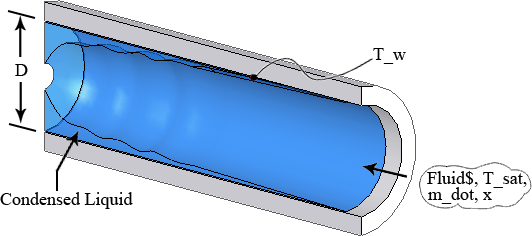Contents
- Index
Cond_HorizontalTube

Procedure Cond_HorizontalTube(Fluid$, m_dot, x, T_sat, T_w, D : h_m, F$) calculates the heat transfer coefficient for condensation of saturated vapor of quality, x, inside a circular tube. The condensation heat transfer coefficient for flow within a horizontal tube can also be determined using the Cond_tube procedure - use of the Shah correlations is recommended.
Inputs:
Fluid$ - string variable representing a fluid/vapor in the EES data base.
m_dot - mass flow rate [kg/s] or [lbm/min]. If m_dot is 0, the procedure returns the heat transfer coefficient corresponding to film condensation
x - mass vapor fraction (quality) of vapor
T_sat - the saturation temperature of the incoming vapor in [C], [K], [F], or [R].
T_w - the temperature of the inside surface of the tube in [C], [K], [F], or [R].
D - inner diameter of the tube in [m] or [ft]
Outputs:
h_m - the mean heat transfer coefficient in [W/m^2-K] or [Btu/hr-ft^2-R]
F$ - string variable indicating the flow regime
Notes:
This procedure is responsible for determining the property data of the fluid specified. The latent heat of evaporation is modified based on the correction term developed by Rohsenow (1956). This correction term accounts for the nonlinearity of the temperature profile due to convection effects. The correlation used is that of Dobson and Chato (1998) as presented in section 7.5.2 of Nellis and Klein. If the mass flow rate is greater than zero, this correlation calculates the mass flow rate per unit area and the Froude number and chooses whether the flow regime is stratified wavy, annular, or transitional. There has been selective experimental validation and recommentation of the correlation by Cavallini et al. (1995) and Smit et al. (2002). However, in testing of high pressure refrigerants (R125, R32, R410A), the Dobson and Chato correlation strongly overpredicts the heat transfer coefficient.
If m_dot (the mass flowrate) is set to 0, the procedure returns the heat transfer coefficient corresponding to fim condensation recommended by Chato (1962) as reported in Incropera and Dewitt (2002).
Example:
$UnitSystem SI C Pa J
Fluid$='R134a'
x=0.2
m_dot=0.005 [kg/s]
T_sat=50 [C]
T_w=25 [C]
D=0.01 [m]
call Cond_HorizontalTube(Fluid$, m_dot, x, T_sat, T_w, D : h_m, F$)
{Solution: h_m=948.9 [W/m^2-K]}
Condensation Index
See also: Cond_tube
